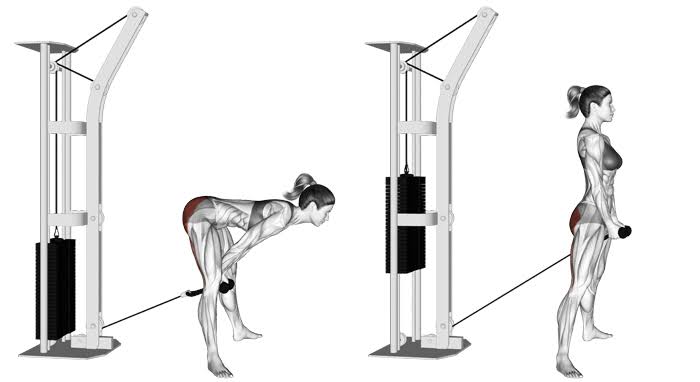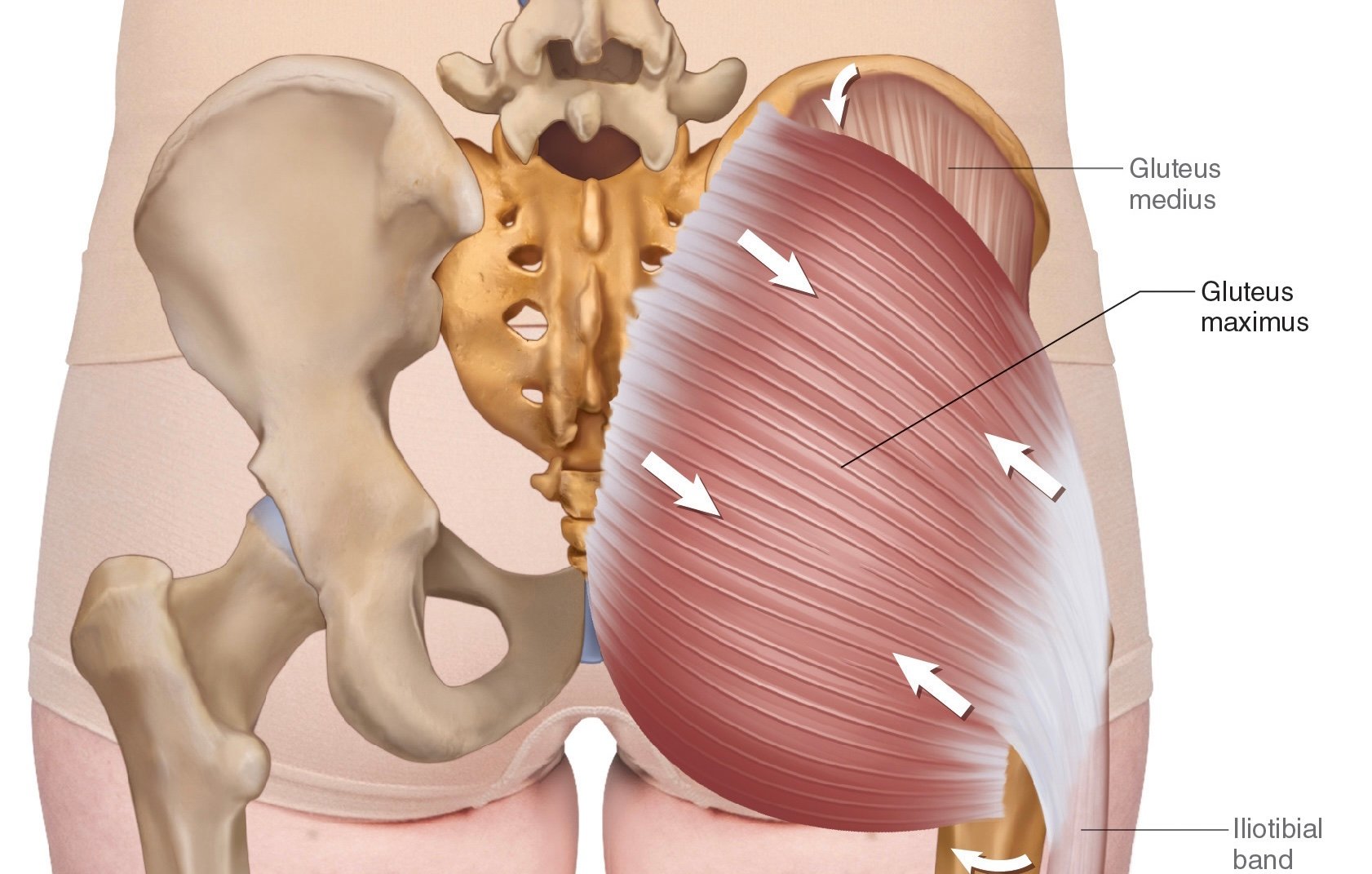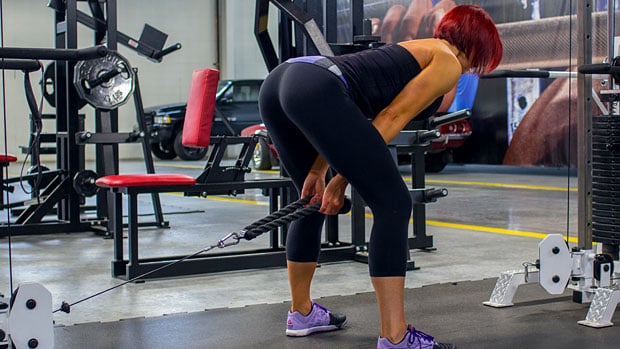Cable pull-through is one of the most underutilized exercises for posterior chain development. Not only does it help with your glute and ham development, but it also improves muscular endurance, hip flexion, and extension mechanics, helps with muscle imbalances, corrective routines, and can be a great warm-up exercise.
There are many benefits and alternatives to cable pull-throughs!
The cable pull-through (aka glute pull-through) is a compound exercise that primarily works your hamstrings, gluteus maximus, and lower-back muscles.
Cable-pull through is a hip-hinge functional movement and should be an indispensable part of your training routine. These movements help you perform essential activities such as picking things up off the ground. They also assist in keeping your hips mobile and strengthen muscles that can prevent lower back pain.
The exercise can be highly beneficial for a fitness rookie for balance in the frontal plane and posterior chain (hamstring, glute, calves) muscle recruitment.
Related: The Most Effective Compound Exercises For All Levels of Experience
Cable Pull Through Exercise Details

- Target muscle: Hamstrings, Gluteus Maximus
- Synergists: Erector Spinae, Hamstrings, Adductor Magnus, Soleus
- Mechanics: Compound
- Force: Pull
Benefits of Cable Pull Through
1. Reinforces the Hip Hinge
If you are a beginner, cable pull-through is a great exercise to learn and reinforce proper hip flexion and hinging patterning necessary for advanced lifts like the deadlift.
The added tension in the eccentric phase due to the use of a cable can provide neurological and motor patterning feedback to help increase a lifter’s understanding of what hamstring flexion and extension should feel like.
Check Out: How These Hinge Exercises Can Boost Hip Strength
2. Glute and Hamstring Hypertrophy
Since cable pull-through requires the use of a cable pulley, it increases time under tension, eccentric muscle damage, and overall muscular activation of your glutes and hamstrings.
3. Cable Pulley is a God-send
The cable pull-through can be a deadlift substitute. You might find the perfect resistance on a pulley machine faster than on a barbell while performing the deadlift since a pulley offers a wide range of resistance options.
On top of that, cable pull-through give you a better way to monitor your progress and isolate your working muscles.
4. Muscle Annihilation
While performing the cable pull-through, your target muscles are under constant tension. It aids with establishing a mind-muscle connection and muscular hypertrophy.
The degree of muscle fiber recruitment while performing the cable pulley pull-through can be altered by switching up the time under tension.
Related: The Importance of Mind-Muscle Connection To See Huge Gains
5. A Great Posterior Chain Exercise
Cable pull-through is one of the most reliable posterior chain exercises.
While exercises like the leg curl isolate your hams, cable pull-through helps train your butt, hamstrings, and lower back effectively and at the same time.
6. Cable Pull-Through is Lower Back-Friendly
While performing the exercise, the rope handles stay close to your center of gravity, which means you are less likely to round your back and end up putting unnecessary stress on your lower back.
Must Read: 4 Exercises to Alleviate Lower Back Pain
Muscles Worked While Performing Cable Pull Through
Cable pull-through works the posterior chain muscles, especially around your hips. These muscles are responsible for generating most of your lifting, running, and jumping power.
The cable pull-through target muscles consist of:
1. Gluteus Maximus

The gluteus maximus is the main extensor muscle of the hip. It is the largest and outermost of the three gluteal muscles and makes up a large part of the shape and appearance of each side of the hips. The gluteus maximus is the large muscle driving the powerful hip extension of cable pull through.
2. Hamstrings
Along with your glutes, your hamstrings play a vital role in hip extension and flexion. There are three muscles in the hamstring group; biceps femoris, semimembranosus, and semitendinosus. The hams are involved in explosive lower body movements such as sprinting and jumping.
3. Erector Spinae
The erector spinae run up both sides of your back and are responsible for extending your spine. It is formed of 3 muscles (spinalis, longissimus, and Iliocostalis muscles), and its fibers run more or less vertically throughout the lumbar, thoracic, and cervical regions. These muscles are also important for maintaining posture.
4. Core
The cable pull-through works the muscles of your midsection, including rectus abdominis, obliques, and transverse abdominis. These muscles stabilize your spine and prevent your lower back from rounding.
Next Read: Build a Rock-Solid Core With These Exercises
5. Iliopsoas
The iliopsoas is the primary hip flexor. It consists of major and minor psoas muscles and the iliacus muscle that forms the iliopsoas musculotendinous unit (IPMU). The muscles can function in isolation to stabilize the pelvis and lumbar spine during hip movement and support flexion of the trunk.
How To Perform A Cable Pull Through With Perfect Form
Most people leave gains on the table by performing the exercise with an incorrect technique. Here is how to perform the cable pull-through:
1. Secure a cable attachment to the pulley and adjust it to the lowest height setting on the cable machine.
2. Face away from the cable machine and reach between your legs to grab the rope handles with a neutral grip (palms facing each other).
3. Take a step forward to engage the weight. Make sure you are far enough from the pulley so that the weight remains off the stack at the bottom of the movement while performing the exercise.
4. Stand with an upright torso, feet slightly wider than hip-width apart, and a slight bend in your knees.
5. Your shoulders should be directly over your feet with a neutral head and neck position.
6. Keep your chin tucked throughout the movement, as if you are trying to hold an egg under your chin.
7. Pre-tension your shoulders and hips, and engage your core.
8. Keep your arms straight and elbows locked out throughout the lift.
9. Without letting your toes lift off the floor, hinge at your hips until you feel a stretch in the back of your legs while maintaining a neutral spine. At the bottom of the movement, your lower arms should be between your thighs and hands behind your knees. At this point, your upper body should be at a 45-degree angle with the floor.
10. While maintaining a neutral spine, return to the starting position by driving your heels into the floor. As you rise, squeeze your glutes and thrust your hips forward.
11. Pause and contract your glutes and hams at the top of the movement.
12. Repeat for the recommended repetitions.
Cable Pull Through Tips
- Avoid using your back and focus on pulling with your glutes and hamstrings.
- Do not hyperextend your lower back upon standing. Your body should be in a straight line at the top of the movement.
- Start with light to moderate weight and increase as you become more proficient with the exercise.
Who Should Perform the Cable Pull Through
The cable pull-through can be especially beneficial for:
1. Strenght and Power Athletes
The hip-hinge exercise can help in improving glute activation, muscle hypertrophy, and maintaining proper hip flexion and hamstring flexibility if performed with a full range of motion. All these benefits can add to a strength or power athlete’s performance matrix.
Related: Full Range Of Motion Vs Partials: Which Is The Way To Go?
2. Functional Fitness and Bodybuilding

The cable pull-through can help add glute training volume for increased muscle hypertrophy, endurance and improve muscle activation. The glutes are involved in almost every functional fitness movement and exercise (running, squatting, pulling, jumping, etc.), making this movement pattern a great one to reinforce and strengthen with the cable pull through.
Must Read: Top Exercises To Increase Hip Mobility To Improve Performance
3. General Fitness
The isolated range of motion of the exercise helps fitness rookies understand the proper position and muscle activation for advanced exercises like deadlifts and good mornings.
Ideal Sets, Reps, and Programming for Cable Pull Through
You are not making the most of the cable pull-through if you limit yourself to three sets of 10 reps while performing the lift. You should program the exercise depending on your goals. Here is a quick rundown on the sets and reps you should be performing based on different goals:
I) General Fitness
If your main objective is to build muscular strength, you should perform lower reps for more sets.
- 4-6 sets of 5-8 repetitions, resting 1-2 minutes between sets
II) Muscle Hypertrophy
Most bodybuilding enthusiasts would fair the best by targeting muscle hypertrophy while performing the cable pull-through. The set and rep range mentioned below will perform the best for glute development.
- 4-6 sets of 8-12 reps, resting 60-90 seconds between sets
- Pro tip: Using tempos and isometric holds can increase time under tension (TuT) and muscle fiber recruitment.
Related: Struggling to Build Muscle? Here’s Why Your Muscle Fiber Type is Important
III) Muscle Endurance
Some lifters (especially athletes) might want to train for muscular endurance. In such cases, higher rep ranges and shorter rest periods between sets is the way to go.
- 2-3 sets of 15+ repetitions (at least 45-60 seconds under tension), resting 30-60 seconds between sets
Cable Pull Through Alternatives
Although cable pull-through is an incredibly effective exercise to improve your posterior chain muscles, you can always use a little variety in your workouts. Here are five alternatives and variations you can use to ensure you never hit a plateau:
1. Hyperextension
Also known as the 45-degree back extensions, most people know this lift as a lower back exercise. Hyperextension is a complete posterior chain exercise. Contrary to popular opinion, the goal while performing this exercise should be to minimize lower back movement and maximize movement at the hip. In other words, the goal is a hip extension, and that’s probably what the exercise should be called.
Steps:
- Adjust the pad so that it is right below your pelvic bone.
- Turn your feet out 45-degrees as it winds the hips up into external rotation which makes your glutes work harder.
- Cross your arms over your chest and lower your torso towards the floor until you feel a strain in your hamstrings.
- Round your upper back and maintain this form throughout the exercise.
- Raise your upper body explosively until you are almost parallel to the floor.
- Slowly return to the starting position and repeat for reps.
2. Reverse Deficit Lunge
Most people consider lunges to be a quadriceps exercise. But if you lunge backward, you will feel a higher degree of glute and hamstring muscle fiber recruitment. Want to take your glute and hams activation a step further? Use a 6″ box to perform the deficit variation.
Steps:
- Stand on a 6″ platform with a shoulder-width stance while holding a dumbbell in each hand.
- Take a giant step back.
- Keep your front shin and torso upright, bend your legs, and lower your rear knee down to within an inch of the floor.
- Using the ball of your back foot, push off your back leg and bring your feet back together on the platform.
- Perform the recommended reps with the same leading leg before switching sides.
3. Kettlebell Swing
The kettlebell swing is probably the closest cable pull-through alternative there is. The kettlebell swing is a more explosive exercise as compared to the cable pull-through and focuses on increasing muscle power. On the other hand, there is a constant tension on your posterior chain muscles while performing the cable pull-through which is not the case with the kettlebell swing.
Steps:
- Stand upright with a shoulder-width stance.
- Hold a kettlebell in front of your body with both hands, arms straight.
- With a slight bend in your knees and a flat back, hinge at your hips and swing the kettlebell back through your legs.
- Use that momentum to stand and swing the kettlebell out in front of your body until it is parallel to the floor.
- Thrust your hips forward, and engage your glutes and core as you stand up straight.
- When the kettlebell hits shoulder height, your knees should be straight and glutes contracted in a full hip extension.
- Allow the kettlebell to swing back down through your legs.
- Repeat for recommended reps.
4. Romanian Deadlift
Romanian deadlifts are one of the purest hip-hinge movements and should be a part of every lifter’s exercise arsenal. This variation of the standard deadlift focuses primarily on your hamstrings, building flexibility, strength, and power.
Steps:
- Stand with an upright torso with your feet placed under your shoulders.
- Use an overhand grip to hold the bar at hip level.
- Draw your shoulders back and keep your spine straight.
- Push your hips back as you slowly lower the bar toward your feet.
- Press your hips forward to come into a standing position with the barbell in front of your thighs.
5. Barbell Hip Thrust
Oh, so you do not have a cable pulley machine at your gym? No problem!
The barbell hip thrust will get you a glute and ham pump, unlike anything you have ever experienced before.
Steps:
- Place a loaded barbell parallel to a flat bench.
- Sit on the floor with your back up against the bench. Roll the barbell over your hips until the barbell rests in the crease of your hips.
- With your upper back against the bench, lift your hips slights off the floor.
- Squeeze your glutes and push your feet into the ground as you begin the upward hip thrust.
- Continue contracting your glutes as you push your hips toward the ceiling to achieve full hip extension.
- Pause and squeeze the life out of your hams and glutes at the top of the movement.
- Slowly return to the starting position and repeat for reps.
Conclusion
Whether you are a powerlifter, bodybuilder, or just want a better-looking rear-end, the cable pull-through should be a part of your lower body workout regimen.
Use the variations, alternatives, and different set and rep range combinations laid out in the article to keep your posterior chain muscles guessing and avoid hitting a plateau.
- $5.95 Ground Shipping On Any Purchase In The US! – Shop Now!
- Free Shipping on US orders over $49 USD and 5 lbs or less at eVitamins.com!
- Save up to 70% on Vitamins & Supplements at eVitamins.com!






